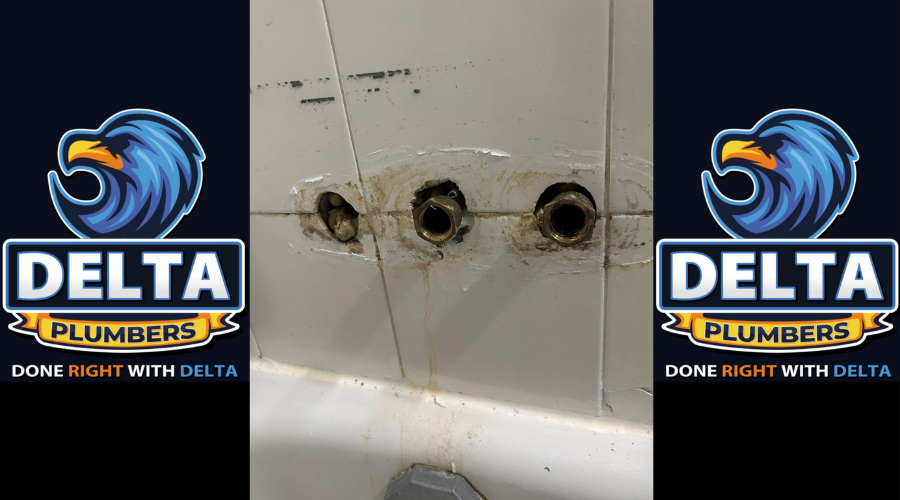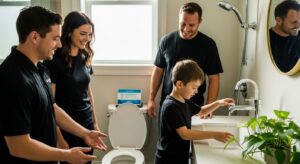Plumbing issues can be a significant source of frustration for homeowners. From minor inconveniences like a dripping faucet to major problems such as a burst pipe, these issues require immediate attention to prevent further damage. This comprehensive guide delves into the most common plumbing problems, how to diagnose them, and effective solutions to fix them. Whether you’re dealing with a clogged drain or a leaky pipe, understanding these problems can save you time, money, and stress.

Picture Source – Delta Plumbers
What is the Most Common Problem in a Plumbing System?
The most common plumbing problem is a clogged drain. This issue can occur in various parts of the home, including kitchen sinks, bathroom sinks, showers, and bathtubs. Over time, debris such as hair, soap scum, grease, and food particles accumulate in the pipes, leading to blockages that slow down or stop the drainage of water. Here’s a closer look at the specifics:
- Kitchen Sinks: Food scraps, grease, and oil are the primary culprits for clogs in kitchen sinks. Even if you have a garbage disposal, certain items like coffee grounds, eggshells, and fibrous vegetables can cause blockages.
- Bathroom Sinks and Showers: Hair, soap scum, and toothpaste are the main contributors to clogs in bathroom sinks and showers. Over time, these substances build up and restrict water flow.
- Bathtubs: Similar to showers, bathtubs often get clogged due to hair and soap residue. Additionally, bath oils and salts can contribute to the problem.
Regular maintenance, such as using drain covers and cleaning them periodically, can help prevent clogs. When clogs do occur, a variety of methods can be used to clear them, ranging from plungers and drain snakes to more advanced techniques like hydro jetting.
Also Read: Boiler Installation Services by Delta Plumbers

Picture Source – Delta Plumbers
How Do You Diagnose Plumbing Problems?
Diagnosing plumbing problems involves a methodical approach to identify the root cause. Here are the steps to effectively diagnose common plumbing issues:
- Listen for Unusual Noises: Bubbling or gurgling sounds in your pipes can indicate a blockage or air trapped in the plumbing system. These sounds often occur when water is draining slowly or when a toilet is flushed.
- Check for Visible Leaks: Inspect areas around sinks, toilets, and appliances for water stains, damp spots, or puddles. Leaks can be caused by worn-out seals, corroded pipes, or loose connections.
- Monitor Water Pressure: A sudden drop in water pressure can signal a leak or blockage in the pipes. Low water pressure can affect multiple fixtures in your home and make daily tasks more challenging.
- Inspect for Slow Drains: Slow drainage in sinks, tubs, and showers often points to a clog. If multiple drains are slow, the issue might be in the main sewer line.
- Observe Water Quality: Discolored or foul-smelling water can indicate contamination or corrosion in the pipes. Rusty water is a sign of aging pipes, while a sulphur smell suggests bacteria growth.
- Utilize Diagnostic Tools: Tools such as plungers, augers, and pipe cameras can help identify blockages or damage within the pipes. For complex issues, professional plumbers use advanced equipment like sewer cameras and pressure testing devices.
Accurate diagnosis is crucial to applying the right solution. While some problems can be fixed with simple DIY methods, others may require the expertise of a professional plumber.
Also Read: Shower Installation Services: A Comprehensive Guide by Delta Plumbers

Picture Source – Delta Plumbers
What Are the Common Mistakes in Plumbing?
Homeowners often make mistakes when attempting to fix plumbing issues themselves. These errors can lead to more significant problems and costly repairs. Here are some common mistakes to avoid:
- Over-Tightening Connections: Tightening fittings and connections too much can strip the threads, crack the fittings, or warp the components, leading to leaks.
- Using the Wrong Tools: Using inappropriate tools can damage fixtures and pipes. For example, using a pipe wrench instead of a basin wrench can mar the finish on a fixture.
- Ignoring Minor Leaks: Small leaks can escalate into significant problems if left unaddressed. Over time, they can cause water damage, mold growth, and increased water bills.
- Using Chemical Drain Cleaners: Harsh chemical drain cleaners can corrode pipes, leading to leaks and weakening the plumbing system. They can also harm the environment and pose health risks.
- Improper Pipe Slope: Incorrect pipe slope can lead to poor drainage and blockages. Pipes need to be installed with the proper slope to ensure water flows correctly.
- Forgetting to Turn Off Water: Always shut off the water supply before starting any plumbing repair. Failing to do so can result in water damage and flooding.
To avoid these mistakes, it’s essential to have the right tools, follow proper procedures, and know when to call a professional plumber.
Also Read: Sewer Repair and Replacement: Delta Plumbers Explains

Picture Source – Delta Plumbers
How to Fix Clogged Pipes in a House?
Clogged pipes are a frequent issue in many households. Addressing them promptly can prevent more severe problems, such as leaks or pipe bursts. Here are some effective methods to fix clogged pipes:
- Use a Plunger: For minor clogs, a plunger can create enough pressure to dislodge the blockage. Ensure you have a good seal around the drain and use a firm up-and-down motion.
- Try a Drain Snake: A drain snake or auger can reach deeper clogs and break them up. Insert the snake into the drain and rotate it to catch and remove the debris.
- Use Baking Soda and Vinegar: This natural solution can dissolve organic matter causing the clog. Pour a cup of baking soda down the drain, followed by a cup of vinegar. Let it sit for 15-30 minutes, then flush with hot water.
- Hydro Jetting: For stubborn clogs, professional hydro jetting uses high-pressure water to clear the pipes. This method is effective for removing grease, scale, and other tough blockages.
- Replace Damaged Pipes: If clogs persist, damaged or old pipes may need replacement. Consult a professional plumber to assess and replace the affected pipes.
Regular maintenance and using drain covers can help prevent clogs. Additionally, avoid pouring grease or disposing of food particles down the sink to reduce the risk of blockages.
Also Read: Gas Line Repair: Everything You Need to Know

Picture Source – Delta Plumbers
How to Clear a Clogged Drain Pipe?
Clearing a clogged drain pipe involves several steps, depending on the severity of the clog. Here’s a detailed approach:
- Identify the Clog Location: Determine if the clog is in a specific fixture or the main drain line. If multiple fixtures are affected, the clog is likely in the main drain.
- Remove Visible Debris: Clear any hair, soap scum, or debris from the drain cover. Use a pair of gloves to pull out any visible gunk.
- Plunge the Drain: Use a plunger to create suction and dislodge the clog. Ensure you have a good seal and use a firm, consistent up-and-down motion.
- Use a Plumbing Snake: Insert a plumbing snake into the drain to break up and remove the blockage. Rotate the snake while pushing it down the drain to catch and pull out the debris.
- Flush with Hot Water: After removing the clog, flush the drain with hot water to clear any remaining debris. Boil a kettle of water and slowly pour it down the drain.
- Avoid Future Clogs: Regularly clean drains and avoid pouring grease or food particles down the sink. Use drain covers to catch hair and debris, and clean them periodically.
For severe clogs or recurring issues, consider professional help. A plumber can use advanced tools like hydro jetting to clear the pipes and ensure the problem is fully resolved.
Also Read: Leak Detection and Repair: All You Need to Know in 2024

Picture Source – Delta Plumbers
What is the Most Common Cause of Pipe Failure?
The most common cause of pipe failure is corrosion. Over time, pipes made of metal, especially older galvanized steel or cast iron, can corrode due to water quality, chemical reactions, and age. Corrosion weakens the pipe walls, leading to leaks and bursts. Here are other causes of pipe failure:
- High Water Pressure: Excessive water pressure can strain pipes and cause them to fail. High pressure can lead to pipe bursts and increased wear and tear on plumbing fixtures.
- Freezing Temperatures: Water inside pipes can freeze, expand, and cause pipes to burst. This is common in areas with cold climates and inadequate insulation.
- Tree Root Infiltration: Tree roots can invade and damage underground pipes. Roots seek out water sources and can crack or crush pipes, leading to blockages and leaks.
- Poor Installation: Improper installation or use of substandard materials can lead to premature pipe failure. Pipes must be installed correctly and meet the required standards to ensure longevity.
Regular maintenance and inspections can help detect and address issues before they lead to pipe failure. Replacing old pipes with modern materials like PEX or PVC can also reduce the risk of corrosion and other failures.
Also Read: Garbage Disposal Repair: Tips from Delta Plumbers

Picture Source – Delta Plumbers
How to Find a Clog in the Main Drain?
Finding a clog in the main drain requires careful inspection and the right tools. Here are the steps to identify and locate a main drain clog:
- Check Multiple Fixtures: If multiple fixtures are draining slowly, the clog is likely in the main drain. For example, if the toilet, sinks, and tubs are all slow to drain, the issue is probably in the main sewer line.
- Listen for Gurgling Sounds: Gurgling noises in drains can indicate a blockage in the main line. These sounds occur when trapped air is forced through the pipes.
- Use a Sewer Camera: A professional sewer camera inspection can pinpoint the exact location of the clog. A small camera is inserted into the drain line, providing a real-time view of the inside of the pipes.
Perform a Dye Test:
Add dye to different fixtures and observe which drain experiences slow drainage, indicating the clog’s location. This method helps identify the specific area where the blockage is affecting the system.
Inspect the Cleanout:
The main cleanout is a critical access point for the sewer line. It’s usually a large pipe with a removable cap located outside your home or in a basement. To check for clogs:
- Remove the Cap: Carefully remove the cleanout cap. Be prepared for a potential rush of wastewater if the clog is severe.
- Observe for Blockages: Look inside for standing water or debris. If you see a substantial amount of waste, the clog may be close to this access point.
Also Read: Blocked Toilet: The Ultimate Guide from Delta Plumbers

Picture Source – Delta Plumbers
Preventative Measures for Common Plumbing Problems
Taking preventive measures can significantly reduce the likelihood of encountering common plumbing issues. Here are some strategies to keep your plumbing system in top condition:
-
Regular Inspections:
-
- Schedule annual inspections with a professional plumber to identify and address potential issues before they become major problems.
- During inspections, focus on areas prone to wear and tear, such as water heaters, pipes, and fixtures.
-
Maintain Proper Water Pressure:
-
- Ensure that your home’s water pressure is within the recommended range (typically 40-60 psi). High water pressure can strain pipes and fixtures, leading to leaks and damage.
- Install a pressure regulator if necessary and monitor pressure levels regularly.
-
Pipe Insulation:
-
- Insulate exposed pipes, especially in unheated areas like attics and basements, to prevent freezing in cold weather.
- Use foam pipe insulation sleeves or heat tape to protect pipes from freezing temperatures.
-
Avoid Chemical Drain Cleaners:
-
- Opt for natural alternatives, such as baking soda and vinegar, to clean and maintain drains.
- Chemical cleaners can be harsh on pipes and are harmful to the environment. Regularly use a strainer to catch debris and avoid using chemical cleaners.
-
Proper Disposal Practices:
-
- Avoid disposing of grease, coffee grounds, and non-degradable items down the sink. These substances can cause blockages and damage to your plumbing system.
- Use trash cans and compost bins for food waste and grease, and educate household members on proper disposal practices.
-
Install Drain Screens:
-
- Use drain screens or catchers in sinks, showers, and bathtubs to prevent hair and debris from entering the pipes.
- Clean these screens regularly to maintain proper drainage and prevent clogs.
Conclusion
Understanding common plumbing problems and their solutions is crucial for maintaining a functional and efficient plumbing system. From diagnosing issues to fixing clogs and preventing future problems, proactive maintenance and timely repairs can save homeowners from costly damage and disruptions. Delta Plumbers is here to provide expert assistance for all your plumbing needs, ensuring that your home’s plumbing system operates smoothly and efficiently.
By staying informed and addressing plumbing issues promptly, you can protect your home and enjoy peace of mind knowing that your plumbing system is in good hands.









